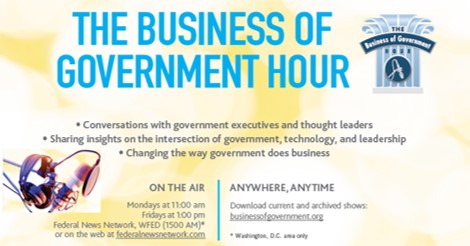
Weekly Roundup: May 2-6, 2022

NEW REPORT: Optimizing Analytics for Policymaking and Governance. The federal government has long recognized the importance of deriving actionable insights from curated data to inform policy development, measure progress, and judge effectiveness of government programs. In this report, Jennifer Bachner draws on a survey of professionals working in and with federal agencies to develop a more comprehensive understanding of how the government uses analytics, the outcomes of these efforts, and the challenges agencies face in their work to further develop analytical capabilities.
Federal CIO Martorana says agencies adjusting to TMF 2.0 model. Don’t call the $10.5 million infusion of funding the Department of Veterans Affairs received to modernize its identity management platform an “award” or a “loan.” Federal Chief Information Officer Clare Martorana prefers to call it an “investment” by the Technology Modernization Fund Board. Martorana said the TMF Board is making an investment in VA to help veterans have seamless and secure access to digital services and benefits.
Federal CIOs Building a Foundation for Successful IT Modernization. Most Federal agencies have undertaken IT modernization efforts intending to change the way IT shops are structured to deliver services to support the mission. Although the benefits of modernization are clear, Federal CIOs agree that agencies still struggle to make these changes.
Cyber EO Anniversary: Feds Like Order’s Aims, See Unrealistic Timelines. As President Biden’s landmark cybersecurity executive order (EO) approaches its first anniversary on May 12, new research shows that most Federal cybersecurity decision-makers solidly back the aims of the EO, but also think that its initial timelines to implement zero trust security are unrealistic.
NIST Releases Updated Cybersecurity Guidance for Managing Supply Chain Risks. The National Institute of Standards and Technology (NIST) on Thursday released an updated cybersecurity guidance for managing risks in the supply chain, as it increasingly emerges as a lucrative attack vector. "It encourages organizations to consider the vulnerabilities not only of a finished product they are considering using, but also of its components — which may have been developed elsewhere — and the journey those components took to reach their destination," NIST said in a statement.
Storytelling and slide decks. Steve Kelman shares ideas about how to inject narrative techniques into your humdrum PowerPoint presentations.
Best Places To Work Online Speaker Series Episode 1: Actions after the FEVS Results. The first guest in the BPTW Speaker Series is Kate Kelley, Chief Human Capital Officer at Army Futures Command. Kate discusses actions her organization take after receiving the FEVS results, and what the FEVS results mean to her team's employee engagement strategy.
DoD Zero Trust Lead: Planning is First Step to Deployment. The federal government is making a big push toward zero trust security architectures, but with an abundance of guidance on what makes a zero trust architecture successful, the looming question for many Federal agencies is ‘where do we start?’ Randy Resnick, senior advisor for the Zero Trust Portfolio Management Office at the Department of Defense (DoD), believes the first step is planning.
The 4 thinking patterns that can bring business success. Companies can unlock a wider range of perspectives from employees identifying four distinct thinking patterns -- analytical, innovative, relational and procedural -- writes Nina Simons, citing research from Dawna Markova and others. Also important is understanding how the three ways employees process information -- "auditory, visual and kinesthetic" -- and which is best for each employee, Simons writes. SmartBrief/Leadership
Ask these 6 questions when building resilient organizations. Leaders who want to build an organization that is agile, sustainable and resilient would do well to pay attention to the complexities of their ecosystem, writes CEO coach Jonathan-Rowan Belchers. Belchers offers six questions leaders should consider in areas of talent, market behaviors and self-awareness of executives. Real Leaders
Why you don't have to be a magician to be a strategist. "Strategy is not magic," writes Richard Rumelt, professor emeritus at UCLA Anderson School of Management, who outlines what successful strategies have in common. "The skilled strategist recognizes the heart of a challenge as the thing blocking an easy solution," Rumelt writes. McKinsey
Purpose is necessary but insufficient. Simon Sinek's famous "start with why" adage is just step one, as ideas require a singular purpose that aligns with organizational goals and culture, writes Denise Lee Yohn. "If you only want to use your purpose as a cause -- and the function and culture of your organization isn't aligned with it, you risk setting it up to remain a rallying cry or inspirational message," Yohn writes. LinkedIn




